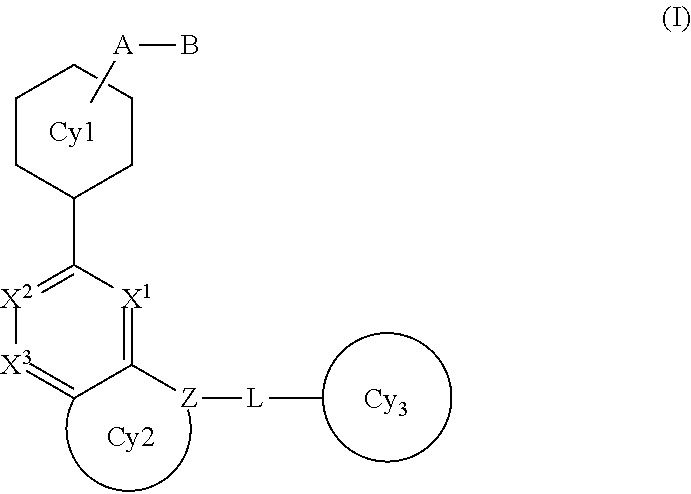Amide compound
- Summary
- Abstract
- Description
- Claims
- Application Information
AI Technical Summary
Benefits of technology
Problems solved by technology
Method used
Image
Examples
reference example 1
methyl 3-(1H-indo1-6-yl)benzoate
[0744]A mixture of 6-bromo-1H-indole (1.00 g, 5.10 mmol), [3-(methoxycarbonyl)phenyl]boronic acid (1.10 g, 6.12 mmol) and tetralds(triphenylphosphine)palladium(0) (295 mg, 0.255 mmol) in 2 N aqueous sodium carbonate solution (20 mL)-1,2-dimethoxyethane (30 mL) was reacted under a nitrogen atmosphere at 90° C. for 5 hr. To the reaction mixture was added saturated brine and the mixture was extracted with ethyl acetate. The organic layer was washed with water, dried over anhydrous sodium sulfate, and concentrated under reduced pressure. The residue was purified by silica gel column chromatography to give the title compound (638 mg, yield 50%) as crystals.
[0745]1H-NMR (CDCl3) δ: 3.95 (3H, s), 6.58 (1H, t, J=2.1 Hz), 7.25 (1H, t, J=2.8 Hz), 7.41 (1H, dd, J=8.3, 1.7 Hz), 7.49 (1H, t, J=7.8 Hz), 7.62 (1H, s), 7.71 (1H, d, J=83. Hz), 7.79-7.87 (1H, m), 7.95-8.02 (1H, m), 8.30 (1H, brs), 8.34 (1H, t, J=1.8 Hz).
reference example 2
methyl 3-(2,3-dihydro-1H-indol-6-yl)benzoate
[0746]To a solution of methyl 3-(1H-indol-6-yl)benzoate (620 mg, 2.47 mmol) obtained in Reference Example 1 in acetic acid (6 mL) was added sodium cyanotrihydroborate (310 mg, 4.94 mmol), and the mixture was stirred at room temperature for 15 hr. Water was added to the reaction mixture, aqueous sodium hydroxide solution was added under ice-cooling to adjust the pH to 12 and the mixture was extracted with ethyl acetate. The organic layer was dried over anhydrous sodium sulfate, and concentrated under reduced pressure. The residue was purified by silica gel column chromatography, and recrystallized from ethyl acetate-hexane to give the title compound (572 mg, yield 91%) as crystals. Melting point 104-105° C.
[0747]1H-NMR (CDCl3) δ: 3.08 (2H, t, J=8.3 Hz), 3.62 (2H, t, J=8.4 Hz), 3.93 (3H, s), 6.89 (1H, d, J=1.3 Hz), 6.95 (1H, dd, J=7.5, 1.7 Hz), 7.19 (1H, d, J=7.5 Hz), 7.46 (1H, t, J=7.7 Hz), 7.70-7.77 (1H, m), 7.95-8.00 (1H, m), 8.23 (1H, t,...
reference example 3
methyl 3-[1-(2,4-dichlorophenyl)-2,3-clihydro-1H-indol-6-yl]benzoate
[0748]To a solution of methyl 3-(2,3-dihydro-1H-indol-6-yl)benzoate (300 mg, 1.18 mmol) obtained in Reference Example 2, 1,3-dichloro-4-iodobenzene (193 μL, 1.42 mmol) and cesium carbonate (577 mg, 1.77 mmol) in toluene (3 mL) were added tris(dibenzylideneacetone)dipalladium(0) (25.6 mg, 0.028 mmol) and 2-dicyclohexylphosphino-2′,4′,6′-triisopropylbiphenyl (16.7 mg, 0.035 mmol), and the mixture was stirred with healing under a nitrogen atmosphere at 100° C. for 40 hr. Water was added to the reaction mixture and the mixture was extracted with ethyl acetate. The organic layer was washed with water and saturated brine, dried over anhydrous sodium sulfate, and concentrated under reduced pressure. The residue was purified by silica gel column chromatography to give the title compound (350 mg, yield 74%) as an oil.
[0749]1H-NMR (CDCl3) δ: 3.22 (2H, t, J=8.3 Hz), 3.86-4.02 (5H, m), 6.62 (1H, d, J=1.3 Hz), 7.01 (1H, dd, J=7....
PUM
| Property | Measurement | Unit |
|---|---|---|
| Fraction | aaaaa | aaaaa |
| Fraction | aaaaa | aaaaa |
| Fraction | aaaaa | aaaaa |
Abstract
Description
Claims
Application Information
 Login to View More
Login to View More - R&D Engineer
- R&D Manager
- IP Professional
- Industry Leading Data Capabilities
- Powerful AI technology
- Patent DNA Extraction
Browse by: Latest US Patents, China's latest patents, Technical Efficacy Thesaurus, Application Domain, Technology Topic, Popular Technical Reports.
© 2024 PatSnap. All rights reserved.Legal|Privacy policy|Modern Slavery Act Transparency Statement|Sitemap|About US| Contact US: help@patsnap.com










